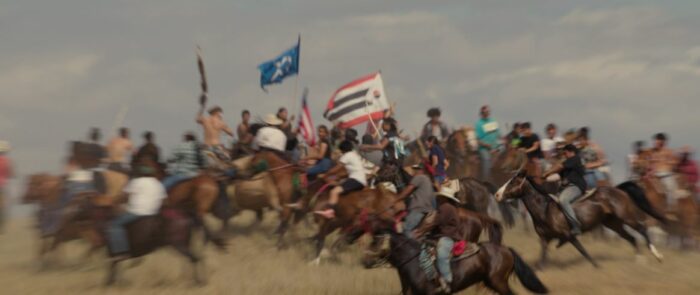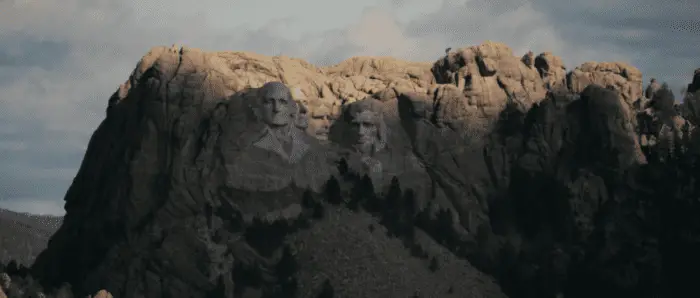American history is filled with injustices committed against the Native Americans. Jesse Short Bull and Laura Tomaselli’s new documentary Lakota Nation vs. United States purports to lift the lid on just one of the wrongs against the Native Americans—the fight of the Lakota people to reclaim the land that historically has always belonged to them—the Black Hills. The Lakota people have always maintained that this land is theirs. It has always been their home and sacred place which is not up for sale. However, over a long period of history, the American government employed many measures, some brutal and inhumane, to displace these indigenous people from their land.
The government was also known to pass a series of unfair treaties to grab the land, which were all eventually either violated or replaced by the government itself. However, the Lakota people have always resisted. They may have been defeated physically throughout history, but their identity, spirit, conviction and love for their land remain whole and unbroken. Thus, this eye-opening documentary is not merely an overview of the fight and injustice that the Lakota people have endured over the years, but also a moving tribute to these people’s heroic resilience against the brutality, discrimination and extraordinary pressure.
Coming into this documentary, one may be reminded of the famous statement made by Red Cloud (1822-1909), who was the leader of the Oglala Lakota: “They [American government/white people] made us many promises, more than I can remember, but they never kept but one: they promised to take our land, and they took it”. As we know, the fight for land by the Native Americans was doomed from the start, but the extent of the duplicity exercised in dealing with these indigenous people was also staggering.

The documentary is divided into two parts: “Extermination” and “Assimilation”. The first part is an overview of some brutal combative methods used historically by the American government against the indigenous population of the Black Hills region. In this part, we are breezed through such historic events as the Battle of the Little Bighorn, which results in the victory of the Native Americans, and the role of Army Officer George Armstrong Custer (1839-1876), and the execution of 38 Sioux warriors ordered by Abraham Lincoln after the Sioux uprising. We are told that it was often the white settlers’ greed for natural resources, such as gold, that made the government violate its own treaties and take more and more land away from the indigenous people.
Throughout the film, the poignant narration given by Oglala poet Layli Long Soldier, amidst some stunning shots of the Black Hills’ natural beauty, gives way to some old TV footage, reels from old Hollywood films and interviews given by the Lakota Nation’s representatives. Lakota Nation vs. United States is undoubtedly a beautiful piece of documentary work, but, arguably, it truly shines only when the Lakota people are given a chance to speak about their severe, intergenerational trauma and when the film decides to focus on just one issue at a time, giving it more time to be elaborated. Arguably, that happens in the middle of the documentary when the talk is about the government’s historic attempts to “assimilate” the native people of the Black Hills.
Non-violent measures can be as damaging and traumatising as any open conflict, and, at one point, the government tried to force the Lakota people into dependency by taking away their main food source (buffalo), as well as their rifles. When everything else failed, the systematic erasure of the Lakota people’s identity, personal pride and self-respect was employed under the guise of providing these people with education, religion and private property. The abuse perpetuated on some children of the Lakota people at the Carlisle boarding school is just one instance in a long series of dehumanising measures thought up by the government to submit the local indigenous population to its will, alongside the unfair and humiliating reservation system. All this is presented convincingly, even if slightly haphazardly, and the biggest takeaway is that this history should never be repeated.

On the more negative side, the documentary could be tidier in its structure and aims, as well as less repetitive in its main message. Its only major fault is perhaps that it tries to do a number of different things all at once, touching on many inter-connected topics. In that vein, it provides a brief general history lesson on the Native American struggle against the white settlers, and talks about both the Lakota Nation’s past legal case—United States v. Sioux Nation of Indians (1980), and Hollywood’s prejudiced presentation of the Native Americans. It also tries to shed light on the current Lakota people’s activism, on the issue of white supremacy and even on the indigenous spirituality and belief. Of course, while covering so much ground, it does not explore any of these topics in depth, and, thus, a more focused and less “scattered” approach would have been more effective, especially in terms of providing greater clarity and substance.
If perhaps a little unfocused, Lakota Nation vs. United States still represents a significant “milestone” in documentary work on the Native American people, joining such films as Trail of Tears, Broken Rainbow, and Reel Injun in illuminating the history and experience of indigenous people living in the United States. One comes away from Lakota Nation burning with indignation regarding the plight of the Lakota people, and that is the point. Candi Brings Plenty from the Oglala Lakota Nation states at one point in the film: “The one way I could empower myself. The one way I could beat [racism] is with my voice.” And, beyond its important history lesson, that is what this documentary provides first and foremost—a voice, a powerful statement against continuous repression experienced by the Lakota Nation. We hear this voice now loud and clear, and even if this does not automatically translate into any change, it still brings awareness, and greater awareness is capable of sowing a seed of change.




